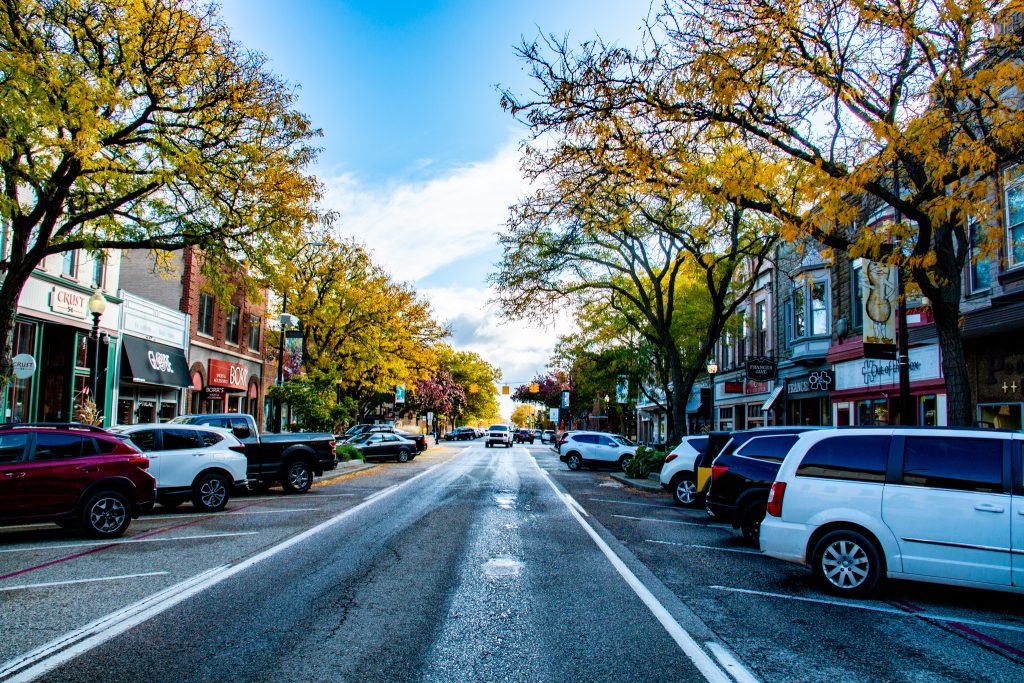
The MRA campaign teaches consumers the economic benefits of shopping locally.
BY: Shandra Martinez
The Michigan Retailers Association’s Buy Nearby campaign is celebrating its 10th anniversary this year.
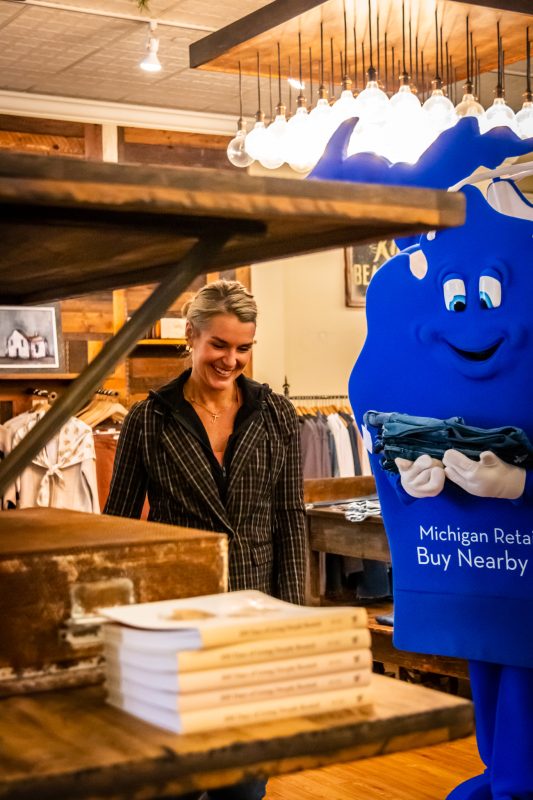
Buy Nearby Guy helping stock shelves in JB and Me in Holland
The clever marketing campaign has played an important role in raising awareness about the huge impact shopping locally can have on the Michigan economy. Former CEO Jim Hallan describes the campaign as the most successful during his 34 years with MRA.
“It was just such a visual impact. You could just feel the sense of excitement and that the message was getting across that you need to keep dollars in the community if you want to support a community,” Hallan said.
The need for a campaign became obvious in 2013 when traditional retail was still struggling because of the economic fallout of the Great Recession and internet shopping was gaining traction.
At the time, internet retailers weren’t required to collect sales tax, giving them a 6% pricing advantage.
MRA’s strategy was two-pronged: Lobby to pass the Main Street Fairness bill, which required internet retailers to collect sales tax to even the playing field, and develop the Buy Nearby program.
“We were successful in getting the Main Street Fairness Act passed, and credit to Tom Scott for developing the mascot, which gave an identity to our program. Also credit to Barb Stein, who was past chair of MRA and led our Buy Nearby committee,” Hallan said. “The program was recognized nationally, and many other state retail organizations followed our lead with their own version.”
A recent analysis, based on 2021 spending data and completed by Public Sector Consultants, found that if Michigan consumers redirected 10 percent of their out-of-state e-commerce spending to local retailers, it would add about $3 billion to the state’s economy.
“One of the reasons why the Buy Nearby campaign has lasted for 10 years and is still growing is because so many people at MRA really bought into it,” said Scott, who served as Vice President of Public Affairs for nearly 25 years before retiring in 2017. “They embraced the concept and worked hard on it. That is definitely a key to success.”
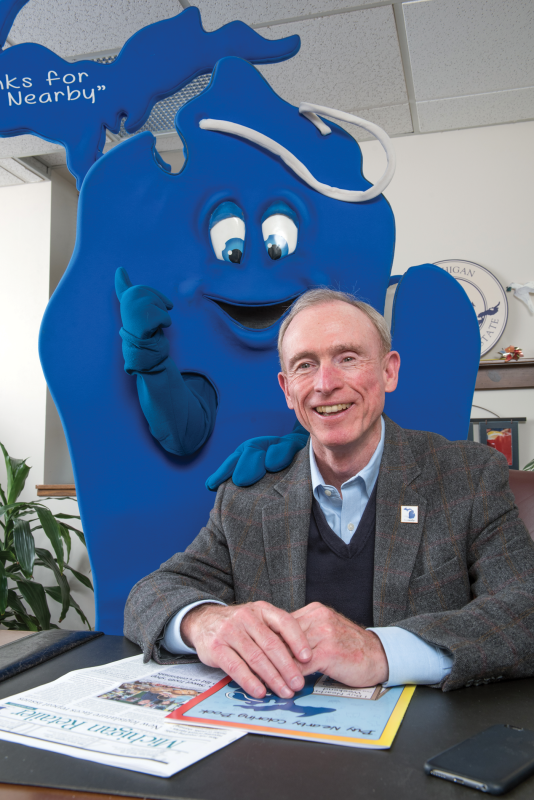
Tom Scott, Retired Vice President of Public Affairs
Good feelings
Many interns and a few others have been the big, clunky mascot over the years. Scott – and his wife, Suzie – were called into service several times. It was a special experience.
“One time while I was in the suit posing for photos with people at the event, I suddenly realized I was smiling even though nobody could see me in there,” Scott said. “It was easy to get caught up in all the good feelings people had toward our mascot.”
The experience inspired Scott to write an unpublished screenplay about a young woman who must take a job as the company mascot after her dad decides she isn’t mature enough to join the family retail business.
“She’s a terrible mascot because she can’t stand the job. But over the course of the film, she ends up understanding it’s all about getting involved, and she becomes community-centered rather than self-centered. And everything turns out happily in the end,” Scott said.
While Scott’s screenplay hasn’t been turned into a Hallmark movie, the sentiment of the Buy Nearby campaign has resonated with shoppers who realize that they can make a difference by how they spend their money.
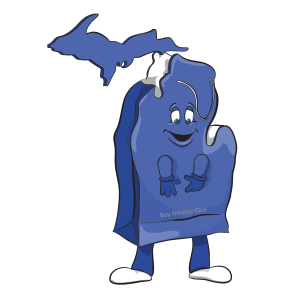
An original mock-up of Buy Nearby Guy
Emphasizing value to communities
The concept for the marketing campaign began at the suggestion of the MRA board. Then-CEO Hallan took up the challenge.
“He really embraced it, and he put together a team to develop this idea,” Scott said. “Everybody at Michigan Retailers got involved in Buy Nearby at some point. Jim was deeply involved himself. It wasn’t something he just delegated.”
MRA brought in a Michigan marketing firm to help develop the concept and the name that underscored the message: Don’t send your money out of the state to some distant internet retailer, because spending the money nearby – anywhere in Michigan – is going to help your community by generating revenues for jobs and for local services, from roads to education, to police protection.
When Buy Nearby launched in 2013, a few similar community programs existed but not a statewide program.
“We were hoping to fill that gap and provide this umbrella program throughout the whole state with a name that people would recognize and respond to. Communities that didn’t have any type of shop local program could use ours, and where there were local programs we could provide additional resources,” Scott said.
Making an impact
Surveys showed that a significant number of retailers saw an improvement in local shopping after the campaign launched.
In the second year, the campaign added the mascot. When leaders learned the most popular mascot maker was an Ohio company, they decided to shop locally and approach the Michigan company that not only put on Detroit’s annual Thanksgiving Day parade, but also created the parade characters.
“We were thrilled when they agreed to make us a mascot at a pretty reasonable cost. And that’s when the fun started, because we had a great visual representation,” Scott said.
Buy Nearby Guy, designed as a giant shopping bag in the shape of Michigan – including the Upper Peninsula – quickly became in-demand for retailer events across the state.
“That’s really when we started to see a difference,” Scott said. “We knew we were moving in the right direction to get people’s attention.”
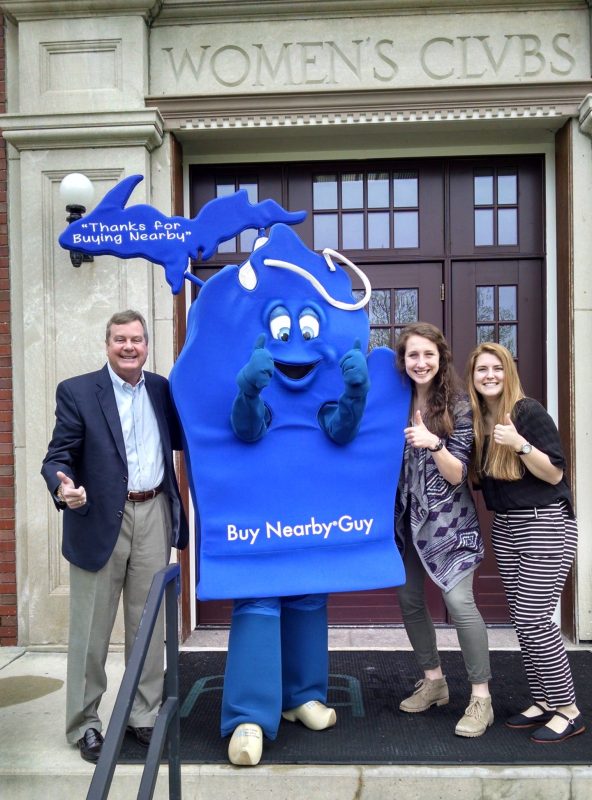
Former President and CEO Jim Hallan with Buy Nearby Guy and interns Abigail Cook and Hannah Lupi
‘Star of the show’
Abigail Cook, who was a Buy Nearby intern in the summer of 2016, remembers the popularity of Buy Nearby Guy.
“The Buy Nearby Guy was really the star of the show,” Cook recalled. “It’s the highlight of every parade, festival, and gathering. A specific crowd pleaser is when Buy Nearby Guy tries to fit himself into narrow doors or spaces. It never works out well…”
She remembers the fun of being part of the MRA team that drove thousands of miles around the state to share the Buy Nearby message.
“Our team was spirited, enthusiastic, and always steadfast through some very hot weather and long travel days,” Cook said.
“My time with Buy Nearby was truly an irreplaceable experience that allowed me to see so much of Michigan and really grow in appreciation for the state’s economy and the people who make it what it is.”
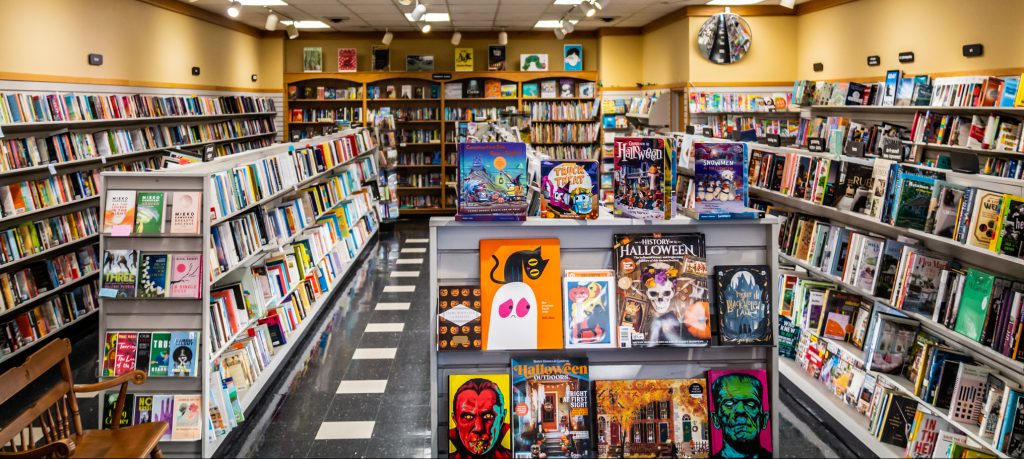
Reader’s World, Holland
